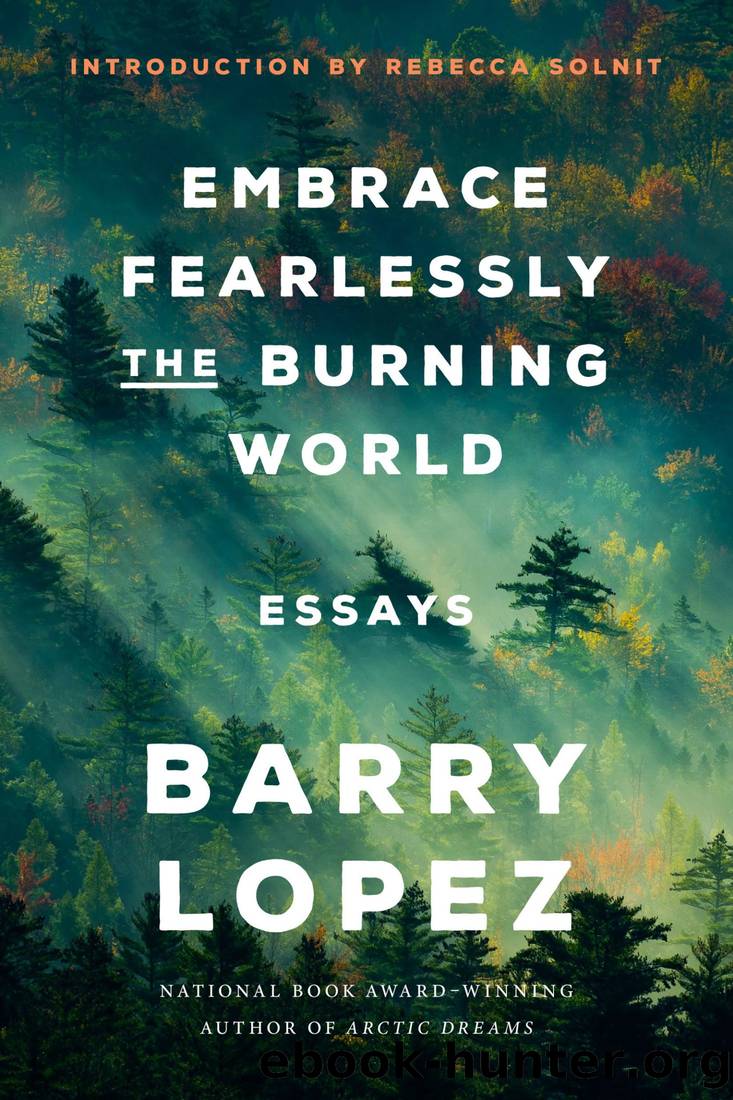Embrace Fearlessly the Burning World: Essays by Barry Lopez

Author:Barry Lopez [Lopez, Barry]
Language: eng
Format: epub
ISBN: 9780593242827
Publisher: Random House
Published: 2022-05-24T00:00:00+00:00
* * *
â
Walking around South Pole Station, a visitor is struck by the cosmic reach, the planetary perspective, of the inquiries here. The focus, in fact, of much of the research now conducted in Antarctica is global or planetary, rather than local. In an era of large, coordinated global geoscience projects and space probes, and concern over global climate, the continent has come into its own. (We tend, I think, to imagine Antarctica as an island the size of perhaps Texas, sheathed in snow and ice and surrounded by a frozen ocean. It is nearly twice the size of Australiaâthe East Antarctic ice sheet alone is about the size of the United States. Antarctica is the planetâs heat sink; because of its size and its position at the end of the Earthâs axisâthere is no comparable landmass in the ArcticâAntarctica drives both the circulation of the worldâs oceans and the circulation of the atmosphere.)
Greenhouse gases and ozone depletion have brought Antarctic research into high public profile and created, rather suddenly, a transnational perspective on human fate. (Greenhouse gases such as methane and carbon dioxide, by trapping heat in the Earthâs atmosphere, can trigger a dramatic shift in the pattern of global climate. The ozone layer protects biological organisms against ultraviolet radiation, which causes cancer in humans and can be lethal in its effect on certain plants and smaller creatures, especially in the upper layers of ocean water.) Interest in Antarctic research in these areas is apt to grow rapidly for one reason: Adverse effects on global climate are likely to appear in Antarctica first, because of the central role the continent plays in the Earthâs weather and because of the pristine nature of its physical environment. Antarctica serves, then, as an early-warning station and, with the information in its ice cores, as a sort of archive for the atmosphere.
The accumulation of environmental and climatic records, and the rather recent realization of the pivotal role Antarctica plays in global research programs, are direct results of its having been dedicated to scientific research in 1956, in preparation for the International Geophysical Year. This arrangement was formalized in 1959 with the drafting of the Antarctic Treaty. (When the treaty was signed it set a precedent in disarmament negotiations; for mutual, on-site inspections; and for devising a legal framework for international management of the seafloor and space. Today no one need show a passport to visit the continent. Military maneuvers, weapons siting, and the disposal of nuclear waste are all prohibited. And the scientific work of any signatory nation is open to the inspection of any other signatory.)
Antarctica draws several hundred scientists each year from about twenty-five nations to pose questions about cosmology and climate, about the lives of penguins and seals and the behavior of ice, questions oddly eminent in this modernist landscape without a national politics.
To get a sense of direction at the pole, a visitor faces a Gordian knot. From the pole itself there is only one directionânorth. East and west are unfetchable.
Download
This site does not store any files on its server. We only index and link to content provided by other sites. Please contact the content providers to delete copyright contents if any and email us, we'll remove relevant links or contents immediately.
| Diaries & Journals | Essays |
| Letters | Speeches |
The Rules Do Not Apply by Ariel Levy(4858)
Bluets by Maggie Nelson(4472)
Too Much and Not the Mood by Durga Chew-Bose(4271)
Pre-Suasion: A Revolutionary Way to Influence and Persuade by Robert Cialdini(4144)
The Motorcycle Diaries by Ernesto Che Guevara(4009)
Walking by Henry David Thoreau(3892)
Schaum's Quick Guide to Writing Great Short Stories by Margaret Lucke(3318)
What If This Were Enough? by Heather Havrilesky(3270)
The Daily Stoic by Holiday Ryan & Hanselman Stephen(3230)
The Day I Stopped Drinking Milk by Sudha Murty(3159)
The Social Psychology of Inequality by Unknown(2937)
Why I Write by George Orwell(2874)
Letters From a Stoic by Seneca(2736)
A Short History of Nearly Everything by Bryson Bill(2629)
A Burst of Light by Audre Lorde(2546)
Insomniac City by Bill Hayes(2495)
Feel Free by Zadie Smith(2434)
Upstream by Mary Oliver(2341)
Miami by Joan Didion(2322)
